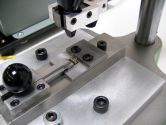Small Screw Questions Answered by Design Tool, Inc.
 - How do you define “small” screws?
For screw feeding systems, I would define “small” screws as screw sizes smaller than #4 for American National Standard or ANSI screws. For metric screws, sizes smaller than 3mm would also be considered “small” screws.
- What types of assembly applications typically use small screws (e.g., portable electronics; eyeglasses; hearing aids; etc.)?
Examples of assembly applications that typically use small screws include circuit board assemblies, medical devices, electrical or electronic components, small toy assemblies, etc. More examples include cell phones, hand tools, laptops.
- Are you seeing more demand for small screws today?
Yes, I believe that there is more demand for small screws today, which can be partly explained by the increase of electronic devices and circuit board applications in industry and consumer products.
- Do any particular type of small screws cause more problems than others (e.g., height; diameter; etc.)?
Screws that have overall length to head diameter ratios that are close to 1:1 are very problematic to feed successfully. The rule of thumb is that the overall screw length needs to be longer that the major diameter of the screw head. Also, small screws that have a disproportionately large drive size, such as a #4 screw with a #2 Phillips drive can be difficult to drive in an autofeed system, as the clearance bore for the driver bit will be larger than the clearance bore required for the screw head diameter. This could cause quivering in the screw barrel.
- Does the type of material that a screw is made out of affect the type of assembly automation that can be used?
The fastener material can affect the type of assembly automation that can be utilized. Ferrous materials such as steel and stainless steel typically do not cause any problems. Aluminum and brass screws can be automated as well. However, screws having sealing material beneath the head can cause problems with feed escapements, perhaps forcing a different type of system to be used. Nonferrous screws cannot be easily presented with screw presenters using magnetic bits or holder. It would require a vacuum pick up because of the metal.
- What are some of the challenges of feeding small screws?
As mentioned previously, the biggest challenge in feeding small screws is the overall length to head diameter ratio. The closer that ratio is to 1:1, the more difficult it becomes to maintain the correct orientation of the screw in the feed escapement mechanism. Also, with smaller screws, the tolerances of the feed components must be held more closely (tighter) to insure that the mechanism will function correctly. Some small screws are difficult to orientate in the bowl before entering in the feed mechanism because of the weight and size of the head.
- How is DTIÂ addressing that challenge?
DTI is addressing the challenge of feeding smaller screws with custom designs of our feed systems, including slide systems that control the screw until it is released into the feed tube. Our patented feed systems are very adaptable for smaller screw applications.
- What types of feeding systems are typically used with small screws (e.g., vibratory; drum; sword; etc.)?
Typically, DTI uses vibratory feed bowl systems for small screws just as they are in larger screw applications. However, the scale of the feed orientation and escapement components becomes smaller with small screws.
- What are the challenges of driving small screws?
The primary challenges in driving small screws with an auto feed system are maintaining the correct screw orientation within the screwdriver components and clearance around the screw head for the driver components to access location in the customer’s assembly parts.
- How is DTIÂ addressing that challenge?
Our driver components can be designed to fit into small areas and still allow the screw to exit the driver. Also, we offer different types of drivers such as our Rigid or Counterbore systems that enable us to successfully drive most small screw applications.
- What is the smallest screw that can be fed (e.g., #000)?
The smallest screw size that is practical to be fed and driven is a #0 screw size due to limitations in the tube sizes for screw delivery. For a feed mechanism only without a blow tube, a smaller size is possible.
- What is the biggest mistake that engineers make with assembly applications involving small screws?
The biggest mistake that we see with assembly applications involving small screws is the lack of clearance allowed around the screw head for driver components(e.g., screws are too close to the wall of the customer’s application). Also receiving applications from customer where assembly parts are not put together well for good part alignment.
|